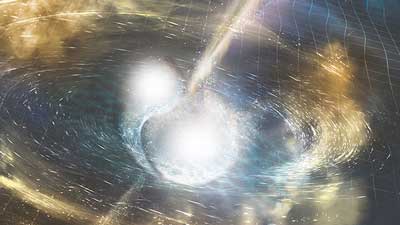| Sep 09, 2019 |
Afterglow sheds light on the nature, origin of neutron star collisions
|
|
(Nanowerk News) The final chapter of the historic detection of the powerful merger of two neutron stars in 2017 officially has been written. After the extremely bright burst finally faded to black, an international team led by Northwestern University painstakingly constructed its afterglow — the last bit of the famed event’s life cycle.
|
|
Not only is the resulting image the deepest picture of the neutron star collision’s afterglow to date, it also reveals secrets about the origins of the merger, the jet it created and the nature of shorter gamma ray bursts.
|
 |
| An artistic rendering of two neutron stars merging. (Image: NSF/LIGO/Sonoma State/A. Simonnet)
|
|
The study will be published in The Astrophysical Journal Letters ("The optical afterglow of GW170817: An off-axis structured jet and deep constraints on a globular cluster origin"). Fong is an assistant professor of physics and astronomy in Northwestern’s Weinberg College of Arts and Sciences and a member of CIERA (Center for Interdisciplinary Exploration and Research in Astrophysics), an endowed research center at Northwestern focused on advancing studies with an emphasis on interdisciplinary connections.
|
|
Many scientists consider the 2017 neutron-star merger, dubbed GW170817, as LIGO’s (Laser Interferometer Gravitational-Wave Observatory) most important discovery to date. It was the first time that astrophysicists captured two neutron stars colliding. Detected in both gravitational waves and electromagnetic light, it also was the first-ever multi-messenger observation between these two forms of radiation.
|
|
The light from GW170817 was detected, partly, because it was nearby, making it very bright and relatively easy to find. When the neutron stars collided, they emitted a kilonova — light 1,000 times brighter than a classical nova, resulting from the formation of heavy elements after the merger. But it was exactly this brightness that made its afterglow — formed from a jet travelling near light-speed, pummeling the surrounding environment — so difficult to measure.
|
|
“For us to see the afterglow, the kilonova had to move out of the way,” Fong said. “Surely enough, about 100 days after the merger, the kilonova had faded into oblivion, and the afterglow took over. The afterglow was so faint, however, leaving it to the most sensitive telescopes to capture it.”
|
Hubble to the rescue
|
|
Starting in December 2017, NASA’s Hubble Space Telescope detected the visible light afterglow from the merger and revisited the merger’s location 10 more times over the course of a year and a half.
|
|
At the end of March 2019, Fong’s team used the Hubble to obtain the final image and the deepest observation to date. Over the course of seven-and-a-half hours, the telescope recorded an image of the sky from where the neutron-star collision occurred. The resulting image showed — 584 days after the neutron-star merger — that the visible light emanating from the merger was finally gone.
|
|
Next, Fong’s team needed to remove the brightness of the surrounding galaxy, in order to isolate the event’s extremely faint afterglow.
|
|
“To accurately measure the light from the afterglow, you have to take all the other light away,” said Peter Blanchard, a postdoctoral fellow in CIERA and the study’s second author. “The biggest culprit is light contamination from the galaxy, which is extremely complicated in structure.”
|
|
Fong, Blanchard and their collaborators approached the challenge by using all 10 images, in which the kilonova was gone and the afterglow remained as well as the final, deep Hubble image without traces of the collision. The team overlaid their deep Hubble image on each of the 10 afterglow images. Then, using an algorithm, they meticulously subtracted — pixel by pixel — all light from the Hubble image from the earlier afterglow images.
|
|
The result: a final time-series of images, showing the faint afterglow without light contamination from the background galaxy. Completely aligned with model predictions, it is the most accurate imaging time-series of GW170817’s visible-light afterglow produced to date.
|
|
“The brightness evolution perfectly matches our theoretical models of jets,” Fong said. “It also agrees perfectly with what the radio and X-rays are telling us.”
|
Illuminating information
|
|
With the Hubble’s deep space image, Fong and her collaborators gleaned new insights about GW170817’s home galaxy. Perhaps most striking, they noticed that the area around the merger was not densely populated with star clusters.
|
|
“Previous studies have suggested that neutron star pairs can form and merge within the dense environment of a globular cluster,” Fong said. “Our observations show that’s definitely not the case for this neutron star merger.”
|
|
According to the new image, Fong also believes that distant, cosmic explosions known as short gamma ray bursts are actually neutron star mergers — just viewed from a different angle. Both produce relativistic jets, which are like a fire hose of material that travels near the speed of light. Astrophysicists typically see jets from gamma ray bursts when they are aimed directly, like staring directly into the fire hose. But GW170817 was viewed from a 30-degree angle, which had never before been done in the optical wavelength.
|
|
“GW170817 is the first time we have been able to see the jet ‘off-axis,’” Fong said. “The new time-series indicates that the main difference between GW170817 and distant short gamma-ray bursts is the viewing angle.”
|

